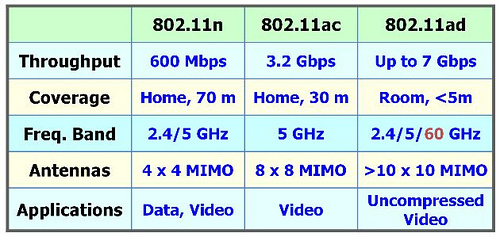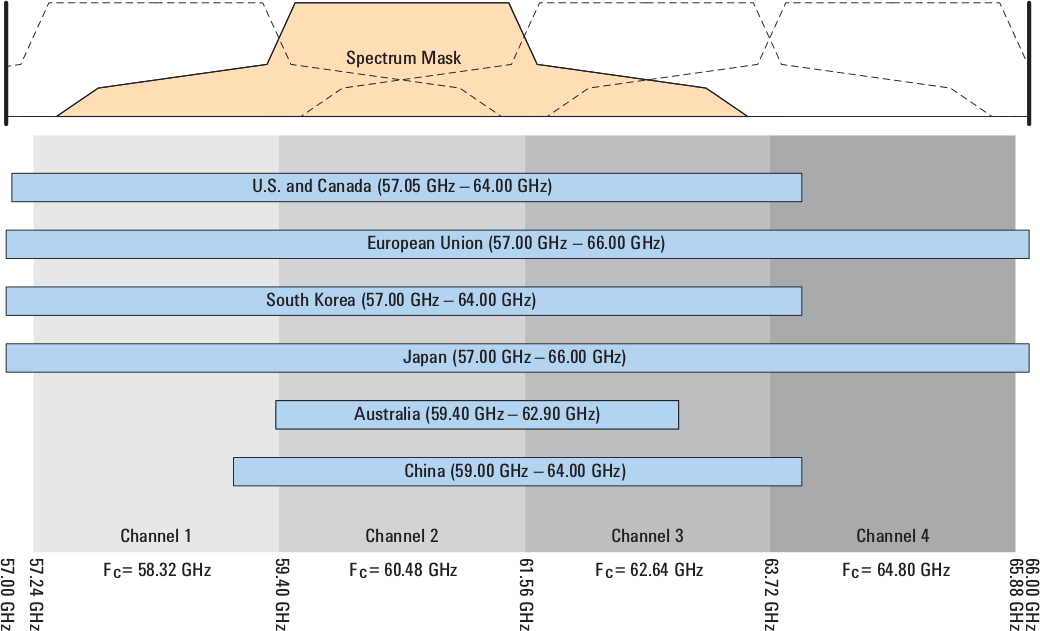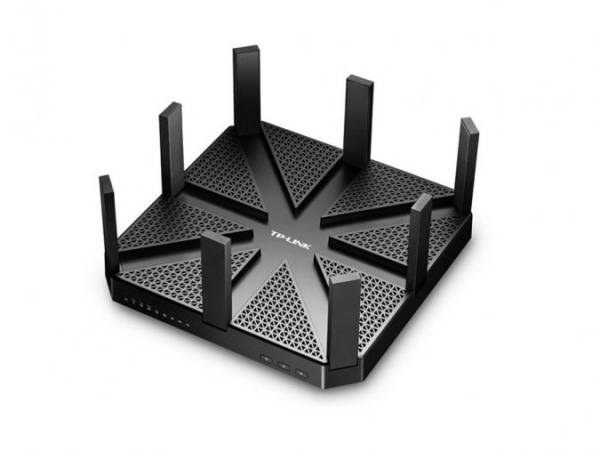802.11ad is the latest and fastest WiFi standard working in the 60 GHz band and delivering up to 7 Gbit per second data transmission rates. The 60 GHz frequency band offers both advantages and disadvantages because it does not penetrate through walls nor water, meaning it can only be used within a room limiting the range, but at the same time it’s more secure since it cannot be snooped from the outside, and for people who worry about health effects it does not penetrate the human body. 802.11ad routers will also be able to switch to 2.4 and 5.0 GHz frequency bands in order to go through walls.

The table above nicely summarize the key features of 802.11ad over 802.11ac and 802.11n, however the throughput row shows the theoretical maximum throughput, but in practice, using 802.11ac as example, clients are often limited to 433 or 866 Mbps, and distance and obstacles will even lower the performance further.
Wikipedia also list the following key features for WiGig MAC and PHY Specification version 1.1:
- Supports data transmission rates up to 7 Gbit/s – more than ten times faster than the highest 802.11n rate
- Supplements and extends the 802.11 Media Access Control (MAC) layer and is backward compatible with the IEEE 802.11 standard
- Physical layer enables low power and high performance WiGig devices, guaranteeing interoperability and communication at Gigabit rates
- Protocol adaptation layers are being developed to support specific system interfaces including data buses for PC peripherals and display interfaces for HDTVs, monitors and projectors
- Support for beamforming, enabling robust communication at distances beyond 10 meters. The beams can move within the coverage area through modification of the transmission phase of individual antenna elements, which is called phase array antenna beamforming.
- Widely used advanced security and power management for WiGig devices
Applications for the higher bandwidth include faster download speeds, 4K wireless video, in-room gaming, etc…

If you want more technical details or/and finding how to test WiFi 802.11ad device, Agilent’s Wireless LAN at 60 GHz – IEEE 802.11ad Explained application note should be a good read.

So when will 802.11ad become available? Very soon, as TPLink unveiled Talon AD7200 Multi-band 802.11ad Wi-Fi Router at CES 2016, supporting up 7200Mbps Wi-Fi speeds over 2.4GHz (800Mbps), 5GHz (1733Mbps), and 60GHZ (4600Mbps) bands, and scheduled to be available in “U.S. stores in early 2016”, while LeEcho, previously known as LeTV, has just launched Le Max Pro (X900) smartphone featuring 802.11ad WiFi in China (also found in Aliexpress), and showcased in ARMDevices.net video where Qualcomm demonstrates 802.11ad with the phone by streaming a 4K video at 50 Mbps to a 802.11ad dock connected an UltraHD TV, and downloading data up to 2.6 Gbps with the phone.
Intrinsyc’s Snapdragon 820 Tablet Mobile Development Platform (MDP) also features 802.11ad, and according to a Qualcomm’s press release, Acer and Asus are working on 802.11ad notebooks, and USB adapter reference designs and development kits will be offered by Sibeam and Peraso.

Jean-Luc started CNX Software in 2010 as a part-time endeavor, before quitting his job as a software engineering manager, and starting to write daily news, and reviews full time later in 2011.
Support CNX Software! Donate via cryptocurrencies, become a Patron on Patreon, or purchase goods on Amazon or Aliexpress






Judging from the real world performance of 802.11n and 802.11ac without a direct line of sight with 802.11ad your device will probably need to touch the router to get any meaningful performance benefit.
@marios
That’s what I was thinking. I’m already having trouble with 5GHz connecting even standing right next to the router. Can’t imagine what the penetration is like with 60GHz.
60GHz wifi, it will be funny. Hold a 802.11ad capable smartphone, signal gone ! Turn around, signal gone !
As it can’t penetrate human body.
What could be the possible real life application of 802.11ad ? Surely developers have something big in their mind.
@Arnab
Possibly something like Miracast with 4K content.
The antenna is usually in top right or left corner of your phone, so it’s unlikely you cover it with your hand, and they are supposed to fallback to 2.4 or 5.0 GHz when the signal is lost.
I don’t know what kind of equipment you guys are using, but I get 866mbps from my wifi router easily at my laptop in a 2-bed apartment. Of course, when I’m in the furthest bedroom, I have to fall back on 802.11N (a mere 200mbps).
When transferring data over the wifi, I’m capped not by the wifi, but by the fact that my NAS is single-disk, 5400 RPM… less than 200mbps when it’s at it’s best.
Can’t wait for 802.11ad to be more common place so I can do away with the wires. More theoretical bandwidth usually translates to more reliability, since there is a lot more room to deal with packet loss, especially for today’s real minimum data rates (5mbps for video streaming), far less than that for voice and video messaging.
@cnxsoft
Supposedly the routers beamshape to pick where the best connection happens. With 60GHz you get bounce off of and around objects. A box shaped room gives you 4 walls and ceiling to bounce the signal all over and around objects.
Talon AD7200 802.11ad router is now available for $350 on Newegg @ http://www.neweggbusiness.com/Product/Product.aspx?Item=9B-33-704-301, and in-store at Fry’s and Microcenter retail locations.
Frys (and BestBuy) now carries 802.11ad routers.
I bought the Netgear Nighthawk X-10, which has a 10Gig SFP port.
I was not able to purchase any other routers as they were sold out of all the other 11ad routers.
Cost runs from 300 to 500 + dollars.
Any .11ad clients available yet?